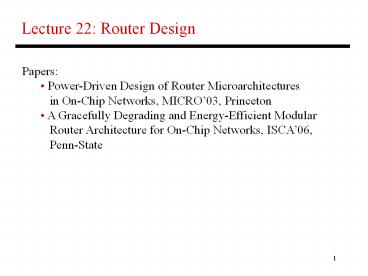Lecture 22: Router Design PowerPoint PPT Presentation
Title: Lecture 22: Router Design
1
Lecture 22 Router Design
- Papers
- Power-Driven Design of Router Microarchitectures
- in On-Chip Networks, MICRO03, Princeton
- A Gracefully Degrading and Energy-Efficient
Modular - Router Architecture for On-Chip Networks,
ISCA06, - Penn-State
2
Router Pipeline
- Four typical stages
- RC routing computation compute the output
channel - VA virtual-channel allocation allocate VC for
the head flit - SA switch allocation compete for output
physical channel - ST switch traversal transfer data on output
physical channel
STALL
Cycle 1 2 3 4
5 6 7 Head flit Body flit 1 Body
flit 2 Tail flit
RC
VA
SA
ST
RC
VA
SA
ST
SA
--
--
SA
ST
--
--
SA
ST
--
--
--
SA
ST
--
--
SA
ST
--
--
--
SA
ST
--
--
SA
ST
--
3
Data Points
- On-chip networks power contribution
- in RAW (tiled) processor 36
- in network of compute-bound elements
(Intel) 20 - in network of storage elements (Intel)
36 - bus-based coherence (Kumar et al. 05)
12 - Contributors
- RAW links 39 buffers 31 crossbar 30
- TRIPS links 31 buffers 35 crossbar
33 - Intel links 18 buffers 38 crossbar
29 clock 13 - Unlike traditional off-chip networks, link
power is not dominant
4
Network Power
- Energy for a flit ER . H Ewire . D
- (Ebuf Exbar
Earb) . H Ewire . D - ER router energy H
number of hops - Ewire wire transmission energy D
physical Manhattan distance - Ebuf router buffer energy Exbar
router crossbar energy - Earb router arbiter energy
- This paper assumes that Ewire . D is ideal
network - energy (assuming no change to the application
and how - it is mapped to physical nodes)
- Optimizations are attempted to ER and H
5
Segmented Crossbar
- By segmenting the row and column lines, parts of
these lines need not - switch ? less switching capacitance (especially
if your output and input - ports are close to the bottom-left in the
figure above) - Need a few additional control signals to
activate the tri-state buffers - (2 control signals, 64 data signals)
- Overall crossbar power savings 15-30
6
Cut-Through Crossbar
- Attempts to optimize the
- common case in
- dimension-order routing,
- flits make up to one turn
- and usually travel straight
- 2/3rd the number of tristate buffers
- and 1/2 the number of data wires
- Straight traffic does not go thru
- tristate buffers
- Some combinations of turns are not allowed such
as E ? N and N ? W - (note that such a combination cannot happen
with dimension-order routing) - Crossbar energy savings of 39-52 at full-load,
with a worst-case routing - algorithm, the probability of a conflict is
50
7
Write-Through Input Buffer
- Input flits must be buffered in case there is a
conflict in a later pipeline stage - If the queue is empty, the input flit can move
straight to the next stage helps - avoid the buffer read
- To reduce the datapaths, the write bitlines can
serve as the bypass path - Power savings are a function of rd/wr energy
ratios - and probability of finding an empty queue
8
Express Channels
- Express channels connect non-adjacent nodes
flits traveling a long distance - can use express channels for most of the way
and navigate on local channels - near the source/destination (like taking the
freeway) - Helps reduce the number of hops
- The router in each express node is much bigger
now
9
Express Channels
- Routing in a ring, there are 5 possible routes
and the best is chosen - in a torus, there are 17 possible routes
- A large express interval results in fewer
savings because fewer - messages exercise the express channels
10
Results
- Uniform random traffic (synthetic)
- Write-thru savings are small
- Exp-channel network has half
- the flit size to maintain the same
- bisection-bandwidth as other
- models (express interval of 2)
- Baseline model power breakdown
- link 44, crossbar 33, buffers 23
- Express cubes also improve
- 0-load latency by 23 -- the
- others have a negligible impact
- on performance
11
Conventional Router
Slide taken from presentation at OCIN06
12
The RoCo Router
13
VC Allocation
- XY routing is deadlock-free
- need a minimum of 8 VCs to
- allow every possible flit traversal
- 2 dx, 2 dy, 2 txy, 1 Injxy, 1 Injyx
- XY-YX routing needs 2 more VCs
- to enable deadlock freedom
- Adaptive routing needs 12 VCs
- Additional constraints on VCs may
- lower performance
14
RoCo Router
- Key features
- Early ejection mechanism for flits destined for
the PE (saves 2 cycles - since they dont have to go through SA and xbar
stages) - Flits are steered to the appropriate crossbar
thanks to routing info - computed in previous stage enables use of 2
2x2 crossbars - instead of 1 5x5 crossbar
- Results show much lower contention probability
for RoCo (?!) - Need fewer and smaller arbiters 2x2 xbar
arbiter algorithm (mirroring) - Generic case for each input port, one arbiter
selects the winner - for each output port, an
arbiter selects the winner - RoCo for each input port, two arbiters select
two winners - for each 2x2 xbar, one arbiter
selects the winner for one port - and
the outcome is mirrored on the 2nd port
15
Results
16
Title
- Bullet

